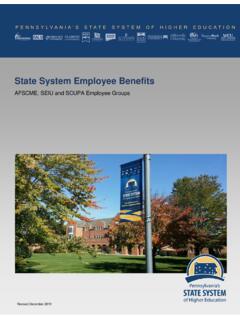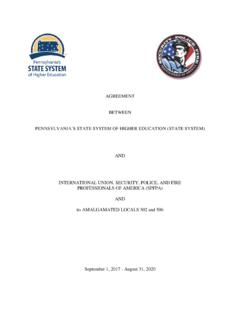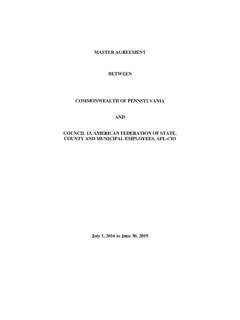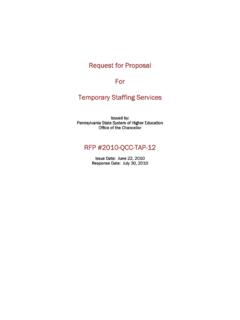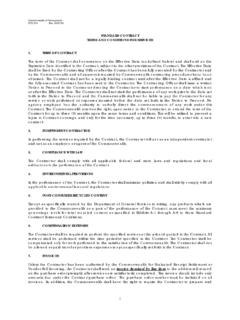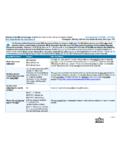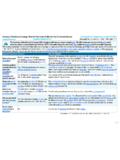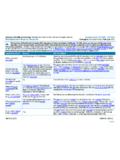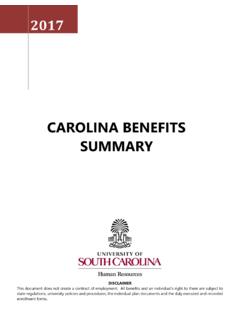Transcription of State System Employee Benefits
1 State System Employee Benefits APSCUF Faculty and Coaches, Nonrepresented, OPEIU (Nurses), SPFPA (Security/Police) Employee Groups 0. Revised July 2018. State System Employee Benefits A Comprehensive Package The Pennsylvania State System of Higher Education provides a comprehensive package of employer Benefits to eligible employees and their enrolled Summary of Benefits dependent(s), which include*: Eligibility 2. Medical and prescription drug Benefits . Health Plan Coverage 3. Generous retirement plans, two options: Defined Contribution - Alternative Retirement Plan (ARP) Prescription Drug 4. Defined Benefit Plan - State Employees' Retirement System Dental/Vision Coverage (SERS), Public School Employees' Retirement System (PSERS). Contribution Rates 5. Tuition Benefits for employees and dependents. Paid time off (holidays, annual leave, sick leave, personal leave).
2 Effective/End Dates 6. Employer-paid dental and vision Benefits . Flexible Spending Account 7. Employer-paid life insurance. Voluntary insurances and additional retirement programs. Group Life Insurance *Specific Benefits may vary based upon university, Employee group and/or collective bargaining unit. Voluntary Life Insurance This summary highlights the health and prescription drug Benefits , supplemental Accident Insurance 8. Benefits , retirement Benefits , leave entitlement, and other voluntary benefit programs for State System Employees covered by APSCUF Faculty and Long Term Disability Coaches, Nonrepresented, OPEIU (Nurses), and SPFPA (Security/Police) Paid Time Off 9. Employees. The Benefits described are available to most employees; however, certain eligibility requirements must be met. Retirement Programs 10. Information is provided for general purposes only.
3 Legal Plan Documents and Voluntary Retirement the collective bargaining agreements will govern any discrepancies that may Tuition Waiver arise. For additional information concerning these Benefits , contact your human Retiree Health Care 11. resource office. Benefits , benefit levels, and eligibility rules are subject to change. Additional Information 12. Important Dates and Information Open Enrollment Spring - Health Care Health plan enrollment changes made during open enrollment are effective July 1. Fall - Flexible Spending Accounts (FSA). FSA enrollment made during open enrollment are effective January 1 of the following year. Make changes to your existing coverage. Elect, drop, or change coverage/add or remove dependents. Enroll in a Flexible Spending Account (Healthcare or Dependent Care) for pre-tax savings. Elections should be completed through Employee Self-Service (ESS) at Upon login, click Employee Self-Service, then Benefits , lastly select Benefits Enrollment.
4 Reminder: If you make any changes to your current coverage during Open Enrollment, you must retain a copy of your Benefits election email confirmation. In the event that there is any discrepancy with your enrollment, you will be required to present the email confirmation to the human resources office. 1. Health Plan Eligibility Employee Eligibility To be eligible for coverage under the State System health plan, you must be a permanent, full-time Employee (including temporary, full-time faculty with at least an academic year contract) or a permanent, part-time Employee (including temporary, part-time faculty with at least an academic year contract) who is scheduled to work every pay period for at least 50% of full-time. Dependent Eligibility The following categories of individuals may be eligible Dependents with other coverage for coverage under the State System health plan for If your spouse is also a State System Employee or an active employees: annuitant eligible to participate in either active coverage Legal spouse or the Annuitant Health Care Program (AHCP), he or Same-Sex Domestic partners, see Dependent she may enroll as a single subscriber under his/her own Eligibility for more information.
5 Plan, or as a dependent under the active Employee 's coverage, but not both. Likewise, dependents may only Children under 26 years of age who meet the be covered under one active group plan or AHCP plan. following requirements: A natural child of your own. If your spouse is covered under the Pennsylvania A legally adopted child (including a child living Employees Benefit Trust Fund (PEBTF), the Employee with the Employee during the probation period). and dependents may be enrolled on each other's A stepchild. policies for the purpose of coordination of Benefits . A minor child for whom the Employee is the court or agency appointed legal guardian, as If your spouse is eligible for employer coverage through evidenced by the court or agency order his/her employer, the following rules apply based on establishing guardianship. your date of employment: A child over the age of 18, for whom the Employee was the child's court or agency appointed legal guardian prior to the child's For Employees Hired PRIOR to July 1, 2013.
6 18th birthday. Spouses added to coverage after July 1, 2001 who are A newborn child of an Employee is eligible for fully-paid employer coverage ( , no automatically covered from the moment of birth Employee contribution for coverage) through their to 31 days after the date of birth. To be covered employer must be enrolled in their employer's coverage as a dependent beyond the 31-day period, the and State System health coverage will provide Benefits newborn child must be added as a dependent as secondary payer only. through the university human resources office within 60 days from date of birth. For Employee Hired ON OR AFTER July 1, 2013. If an Employee enrolls a spouse in the State System Unmarried dependent child 26 years of age or health plan and that person is eligible for coverage under older, who is incapable of self-support because their own employer's plan, the spouse shall be required of a physical or mental disability that to enroll in their own employer's plan for their primary commenced before the age of 26.
7 Coverage as a condition for eligibility for secondary coverage under the State System health plan To view a detailed description and definition of regardless of the cost to the spouse for that coverage. dependent eligibility, see the Dependent Eligibility attachment. Dependent Documentation In order for dependents to be enrolled in coverage, applicable dependent documentation must be provided within the specified time requirements. View the Employee Responsibilities - Qualifying Events attachment for information on how long you have to enroll dependents. Also, view the Dependent Documentation attachment for required documentation needed to enroll dependents. 2. Health Plan Coverage Preferred Provider Organization (PPO). Applicable plan deductibles, coinsurance, and copays are determined by your Employee group. Review the information below for more information.
8 For additional details and information visit the State System websites: - Nonrepresented OPEIU SPFPA - PPO. - APSCUF Faculty and Coaches - PPO. Nonrepresented, OPEIU, SPFPA APSCUF Faculty and Coaches In-network Out-of-network In-network Out-of-network $250 per person, $500 per person, $400 per person, $800 per person, Deductible $500 per family $1,000 per family $800 per family $1,600 per family Member Coinsurance 10% 30% n/a 20%. Out-of-Pocket $1,000 per person, $2,000 per person, $400 per person, $3,200 per person, Maximum $2,000 per family $4,000 per family $800 per family $6,400 per family Primary Care Physician Office $15 copay 30% after deductible $20 copay 20% after deductible Visit*. Specialist Office $25 copay 30% after deductible $45 copay 20% after deductible Visit*. Urgent Care* $25 copay 30% after deductible $50 copay 20% after deductible $100 copay $100 copay $200 copay $200 copay Emergency Room (waived if admitted) (waived if admitted) (waived if admitted) (waived if admitted).
9 Plan pays 100% - Plan pays 100% - Preventive Care* 30% after deductible 20% after deductible no deductible no deductible *Not subject to deductible or coinsurance. Hearing Benefits Enrollment is included with your health plan election. In order to receive hearing Benefits , you must be enrolled in an active health plan. Hearing Coverage Summary $1,250 per ear (maximum of $2,500 for 2 ears) every 36 months. Preventive Care There are no member costs for preventive care at in-network providers the plan pays 100% of the costs for qualifying preventive services. By following the recommendations in the preventive schedule, you may be able to either prevent certain medical conditions, or detect them before they become more serious. Take a moment to review the preventive schedule and, if needed, contact your medical provider to obtain any recommended services.
10 If your medical provider orders diagnostic tests/screenings that are not covered on the preventive schedule, those services may be subject to additional costs ( Deductible and/or coinsurance). 3. Prescription Drug Coverage Enrollment in prescription drug coverage is included with your health plan election. Below are the copay amounts. For detailed information, view the prescription drug coverage summary. To view the prescription website, click here. Retail Copay Mail-Order Copay Prescription Drug Tier (30-day supply) (90-day supply). Generic $10 $20. Brand Drugs, Formulary $30 $60. Brand Drugs, Nonformulary $50 $100. Certain prescription drugs are subject to prior authorization requirements, quantity level limits, or other management programs to ensure that these medications are being used in a safe and effective manner, and to help both you and the health plan control costs.
